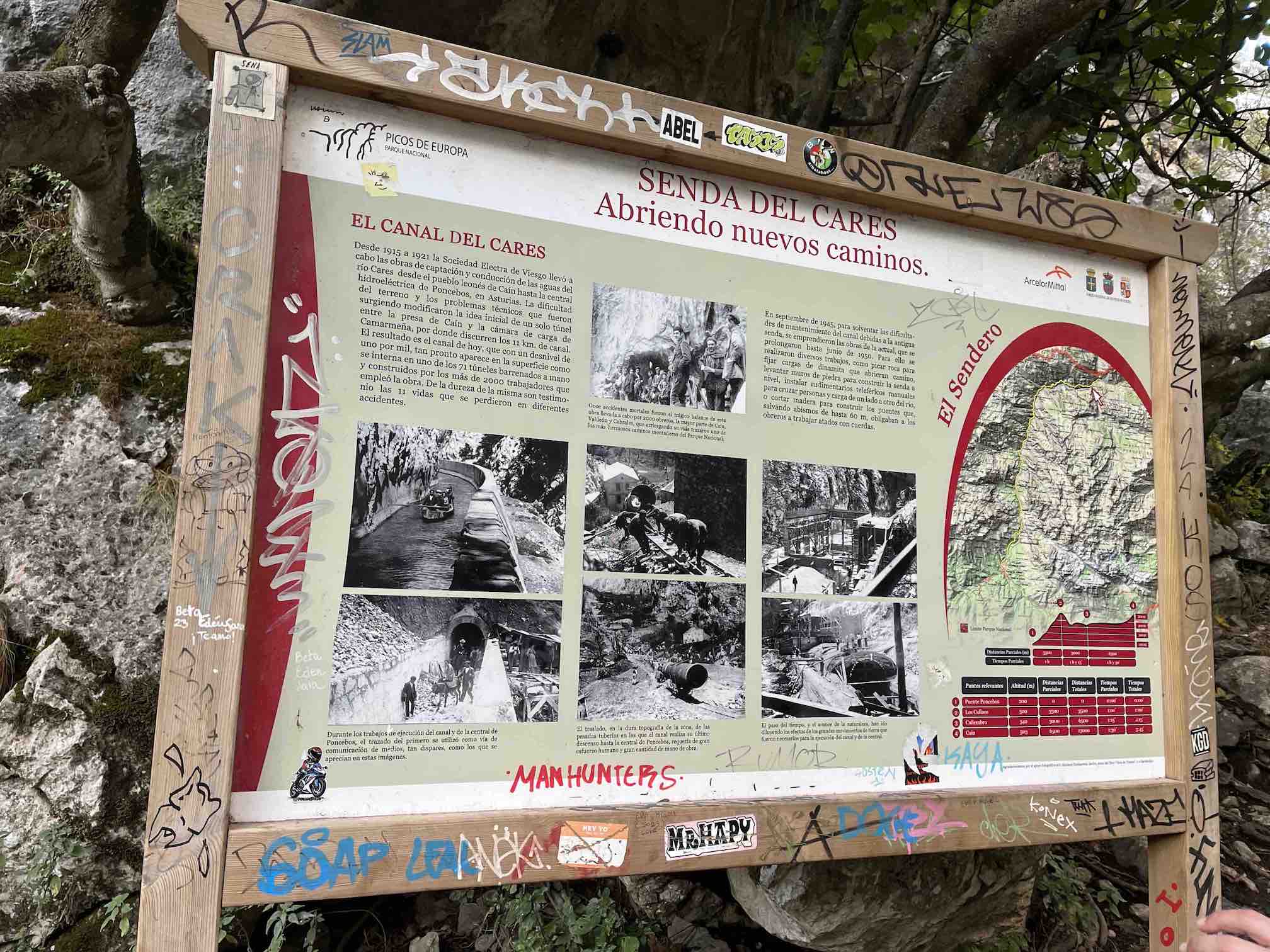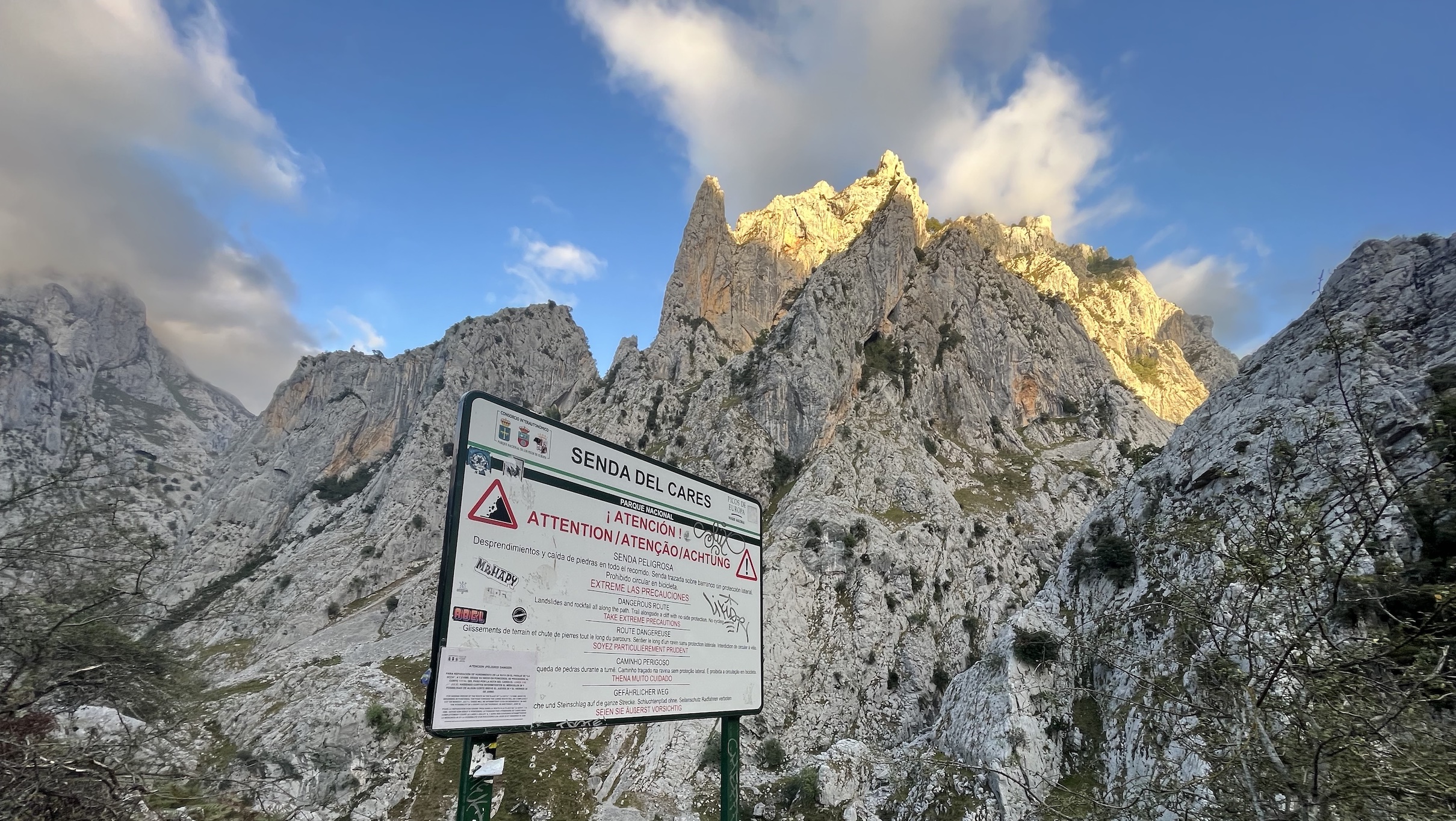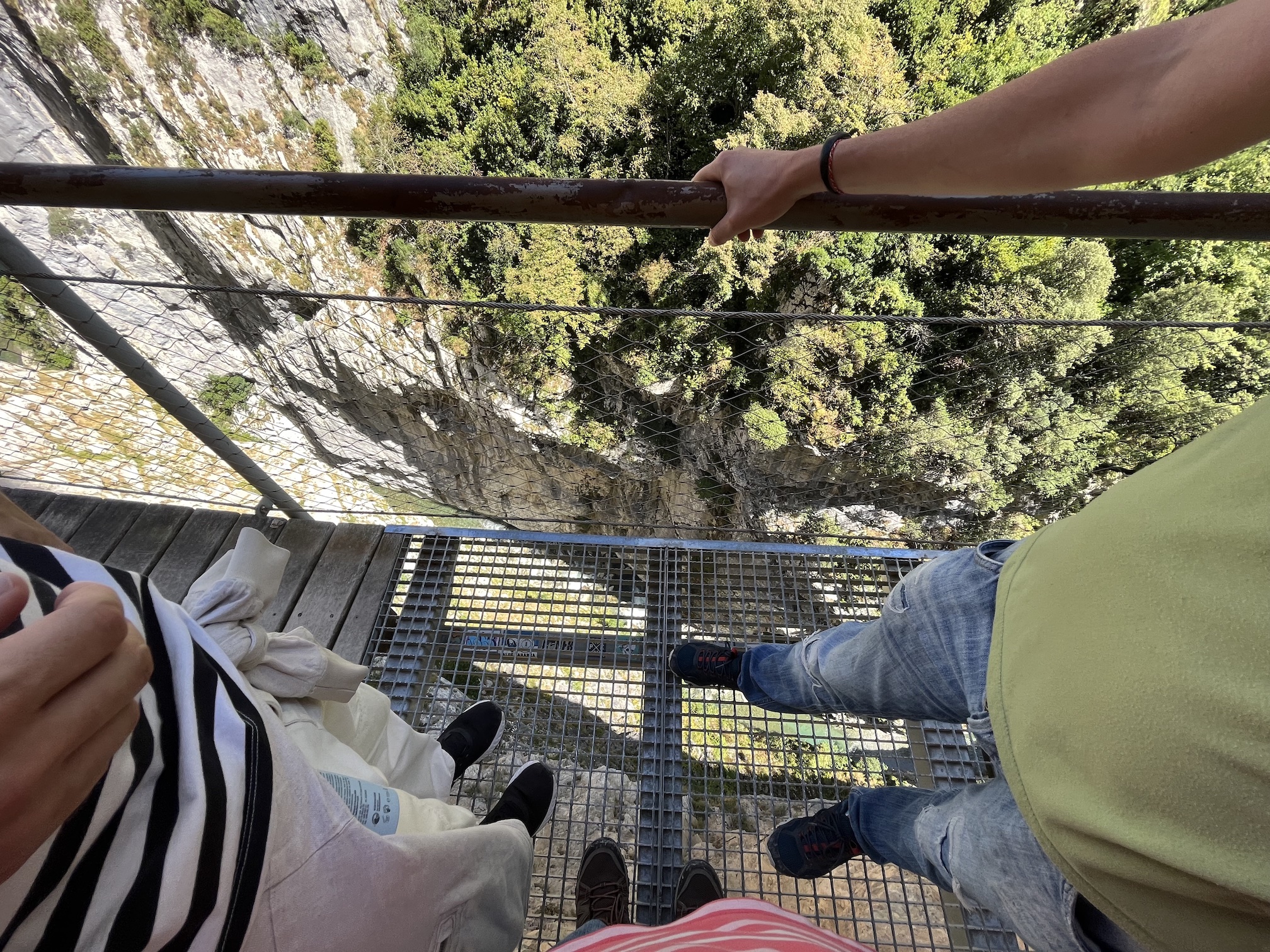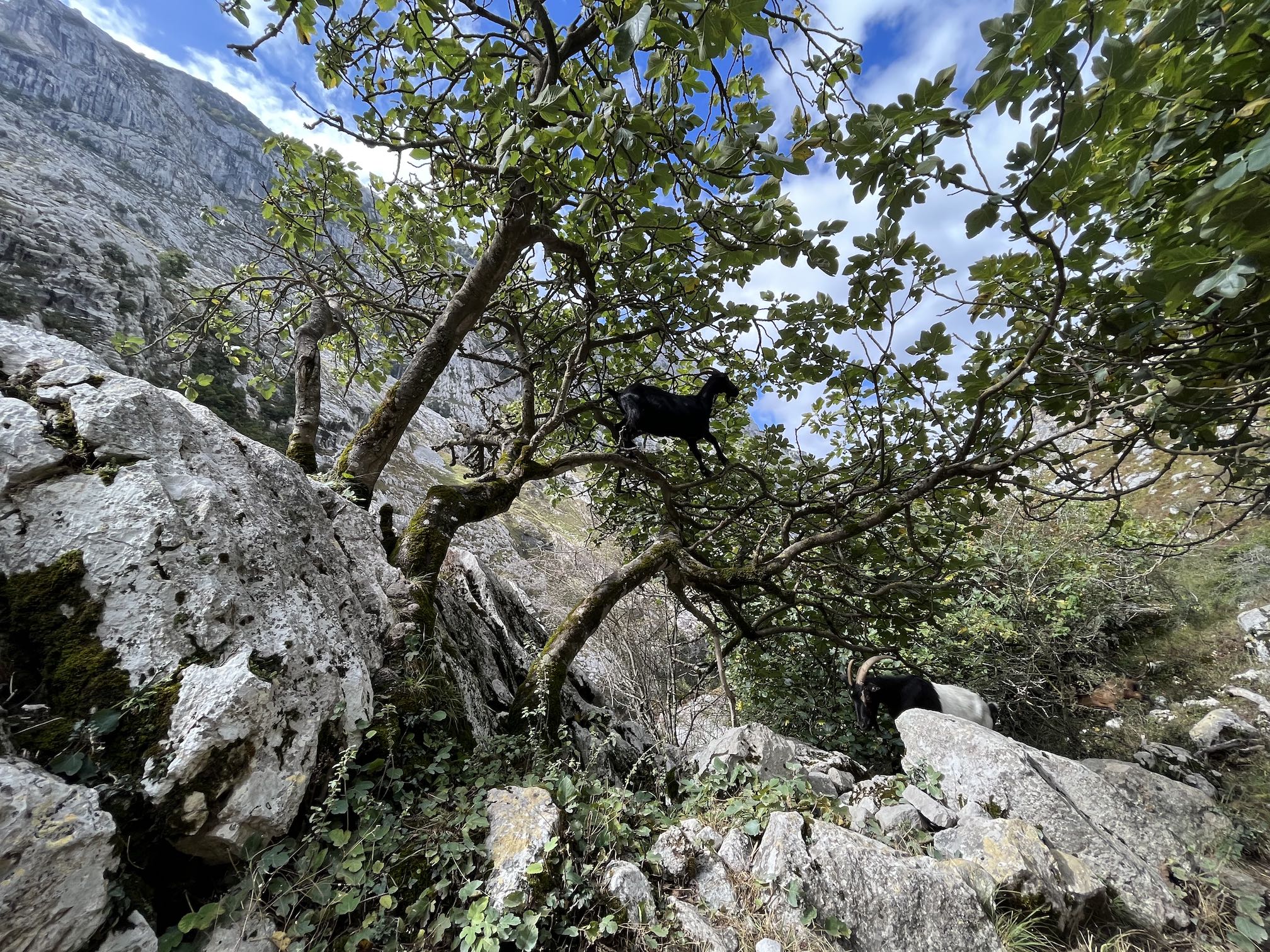After our Camiño Inglés journey, my husband and I went on another summer adventure - this time, outside Galicia and with a good friend. The highlight was trekking through the Picos de Europa on a hiking trail called the Ruta del Cares, where we were awestruck and humbled by the raw magnificence of nature.
Origins of the Trail
 Melquiades Aserón
Melquiades Aserón La Ruta del Cares (The Cares Trail) is named after the Cares Canyon (also called “Garganta Divina” or “Divine Gorge”) that stretches from Poncebos in Asturias (where we began our hike) to Caín in León. It is a part of the old and only route between the villages of Posada de Valdeón and Poncebos, which was used during the construction of a power canal that began in 1916 which, in turn, was part of the Camarmeña Hydroelectric Power Plant project. The current trail is a result of extension work done on the path between 1945 and 1950, which was undertaken to ensure reliable access to the power plant for maintenance work purposes.
The trail itself is considered one of the most beautiful hiking trails in Spain as it goes through Los Picos de Europa (The Peaks of Europe), named as such because they are said to be the first thing that sailors saw when they returned to Europe from the Americas.
The Hike (22.29km)
As we were staying at the Parador Nacional in Cangas de Onis, a town that also calls itself the “Entrance to the Picos de Europa”, we decided to make the most of our time in Asturias by going on another hiking adventure in order to see the famous mountain range up close and personal.
Safety First - Perils Abound!
Extreme natural beauty that can come with a fittingly extreme price for those who dare to venture into it - a terrible price that nature will not hesitate to collect, whether by misfortune or folly.
 Melquiades Aserón
Melquiades Aserón Visitors who opt to start the Ruta del Cares from Poncebos (as we did) are greeted with a multitude of signage that warn about the dangers of hiking on the trail. The juxtaposition of these warning signs against the backdrop of the majestic view of the limestone mountains perfectly encapsulates what lies ahead: extreme natural beauty that can come with a fittingly extreme price for those who dare to venture into it - a price that nature will not hesitate to collect, whether as a result of some misfortune or by sheer folly.
As such, you will need to make sure that you are fully prepared for this hike by doing a thorough research beforehand and by carefully reading everything on the information board that is found at the entrance of the trail.
Based on our experience, the difficulty level of “medium” indicated on official signage (some sources even put its difficulty level as “low” as the route itself remains relatively flat for the most part upon reaching a certain point), beware - the risks associated with this route make it so much more difficult and dangerous than the Camino de Santiago.
Risks include landslides, falling debris, accidentally falling over the edge, and, to a much lesser extent, being headbutted by mountain goats - I kid you not (pun intended).
Here is a list of things to be aware of before attempting to hike on the Ruta del Cares:
 Melquiades Aserón
Melquiades Aserón - Do not attempt to do this route if you suffer from vertigo. I’ve never suffered from vertigo or even had motion sickness my whole life, but the extreme motion parallax that I experienced on this trail was just unbelievable.
- Do not go alone, as cell coverage is virtually non-existent in the parts of the route that you will need it the most. You will someone to call for help in case you injure yourself.
- You must have the stamina to finish at least one leg of the hiking trail (around 12km), as it runs through the mountains. The only other option is to turn back.
- While many sources say that this hiking trail remains flat for the most part, the uphill climbs on this hiking trail are not for the faint of heart, figuratively and literally/medically.
- No cycling allowed.
- No handrails or safety barriers for 99.9% of the way.
- Never, ever, take photos while walking. Stop in a safe spot to take pictures - no Instagram photo is worth losing your life over. Most of the time, pictures don’t even do justice to natural beauty anyway.
- Never, ever, take your eyes off the ground while walking. Stop walking before appreciating the amazing mountain scenery.
- I would only recommend this hiking trail in the summer or on days where there’s 0% chance of rain, as the route is tricky enough as it is. Adding slippery ground to the mix is not worth it.
- The trail is so rocky that, in some parts, it’s easy to slip on the small stones when they rub against each other.
You can find more information online, such as the points listed on this article, but the ones I’ve listed above are those that I believe are the most important for most hikers.
The issue is safety is not something to be trifled with when it comes to the Ruta del Cares, as it is known to take the lives of hikers every year.
What You’ll Need
My husband and I packed more or less the same stuff that we used on our Camino trips, but the essentials are as follows:
- Walking stick - Absolutely necessary for this hiking trail
- Hiking shoes - Footwear that is designed for very rocky terrain is absolutely essential
- Comfortable clothes made from breathable fabric (in summer) or warm materials (during winter months)
- Wide-brimmed hat
- Hiking socks
- Sunscreen
- Sunglasses
- Power bank, charging brick & cable
- Insulated flask
- Ibuprofen (optional) - Take judiciously when muscle pains get too uncomfortable
Boots on the Ground
We set out from Poncebos, which is on the Asturian side of the trail, towards the direction of the Leonese town of Caín, which was around 12km away.
The first hour or so of the hike is spent on a steep, uphill climb, until the path flattens out on the sides of the mountains. Being a limestone mountain, the path is filled with all sorts of stones ranging from small pebbles to huge blocks of stones, most of them with jagged edges with smooth surfaces - an unholy combination of physical properties that caused hell on my legs, knees, feet, and lower back.
Halfway through to Caín, the path begins running through paths dug through the mountains and also through small caves. It was a very sunny day when we went, making it difficult for my eyes to adjust to the abrupt changes in the lighting conditions as we entered the caves, and so I had to use my cellphone’s flashlight.
 Melquiades Aserón
Melquiades Aserón We also walked on the Pasarela de los Martínez, a feat of engineering that was built in 2012 to bridge the gap in the path caused by a landslide, and named after a family of mountaineers who served as guides and guardians of the Picos de Europa.
The rest of the way to Caín was easy and uneventful, except for a couple of funny moments - the first being that time where I announced that the water flowing through one of the canals was saltwater after washing my face (it turned out that it was just sweat mixed with the freshwater), and the other being that time the three of us had a water-splashing fight that filled the mountains with the sound of our laughter.
After a long lunch in Caín (the food was incredibly good because the long walk had worked up a big appetite), we retraced our steps back to Poncebos.
Mountain Goats
One of my most memorable moments during the Ruta del Cares hike was when I first saw a mountain goat - it was not something that I expected at all! As a city boy, I had only seen mountain goats on videos online, and I never really thought I’d ever see one up close.
 Melquiades Aserón
Melquiades Aserón They weren’t wild goats, though, as all of the ones we saw up close had ear tags. The one that I was most impressed with was nonchalantly perched on the branch of a tree.
While the goats were very entertaining, the risks that they posed to hikers, although small, also became evident as we continued the hike.
For example, we saw a nanny goat with kids crowding the trail path, competing for space with hikers. We also saw several billies - I am not sure how aggressive they get, but I would not want to be around when they locked horns with each other during mating season, as everything on the trail was delicate enough without being accidently bumped by a goat and sent flying over the edge.
Finally, the most alarming incident involving goats was when we saw small pebbles falling farther down the path - we looked up and saw that the disturbance was caused by a goat climbing the mountain above us. It was a moment of cold realization that the goats, adorable as they were, could cause accidents if they were to suddenly kick a rock that would come tumbling down on unsuspecting hikers.
Extreme Motion Parallax
Motion parallax is best described as that awe-inspiring visual effect that you get when you’re on board a fast-moving vehicle and you’re looking at a mountain in the distance - things closer to you move fast as you approach the mountain, but your view of the mountain doesn’t change all that much.
While this is something that you’d like to experience when you’re looking at natural wonders like Mt. Everest or Mt. Fuji, this is not something that you’d want to experience when you’re hiking as it can pose a danger. During this hiking trip, I experienced this visual effect, magnified by several factors:
- the relatively fast motion of nearer objects (such as the ground) on one side of my line of vision as I walked,
- the extremely slow-moving view of the mountain on the other side of my line of vision, and
- the great contrast in lighting as, at one point, we were walking in the shade while the mountain on the other side was bathed in sunlight.
The effect was extremely exaggerated when I was walking on parts of the trail where the path was on an almost perpendicular cliff, which caused my view of the fast-moving ground beneath me to abruptly cut out to the slow-moving views of the nearby mountains. It got to the point where I had to shield my eyes to block out the view of the slower-moving mountains on the other side to prevent myself from getting dizzy and falling over the edge of the cliff.
An Unforgettable Experience
The hike on the Ruta de Cares was a truly exhilirating experience that I will remember for the rest of my life, one that taught me an important lesson: the hubris of mankind in its attempts to tame the mighty forces of nature will be its own undoing, unless humanity learns to give nature the respect it deserves.
